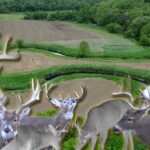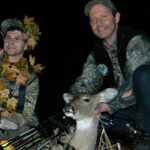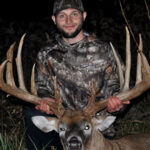Today’s archery technology has made it much easier to shoot long distances consistently, including yardages in the triple digits. Shooting extended distances has become increasingly popular with outdoor celebrities on social media and at 3D shoots, such as the Total Archery Challenge.
However, every year I cringe a little when I hear stories or read posts on social media about long-range shots on game that resulted in poor shot placement and less than ideal outcomes. Inevitably, these chronicles lead to a higher disapproval rate of bowhunting from nonhunters. It can also result in a disappointing hunting experience. Unfortunately, there is often a disconnect between the ability of a person’s bow to shoot long distances and the shooter’s capability behind the bow to effectively do the same during a hunting situation.
Let’s take a closer at what hunters should consider putting into practice before their next hunting season.
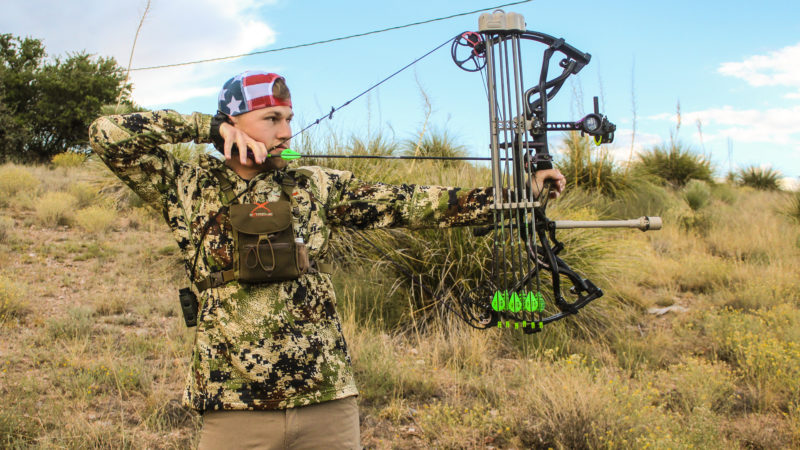
Set a Max Shot Distance
I realize that I am not without fault, as I recollect shots I have taken in the past, that I never should have thought about taking. This is not to say how far you should or should not shoot while on a bowhunt. It is to encourage making an intentional decision to determine what maximum distance you can make a clean and merciful kill shot.
This decision can only be made by each individual. Ultimately, we as hunters, are responsible for the shots that we choose to take. And the shots we choose to take can have a huge impact on our own hunting experience, as well as the image we portray to those that do not hunt. Higher success shots can be taken that lead to shorter blood trails by separating our own shooting capability from our bows shooting ability. Set a max distance, and stick with it.
Personal Experience
While on a mule deer hunt, I found myself in such a situation. I had spotted a bachelor group of five bucks feeding in a small meadow. After about an hour of watching them through my Vortex Vipers and taking video of them, I decided I would be willing to shoot either of the two larger bucks. As they fed, they quickly began to move out of the meadow towards private land, and I was about to miss my chance. The wind was not blowing in my face but was heading at enough of an angle to be in my advantage. I was confident the velvet-tipped bucks would not catch my scent.
I made my move, hustling along the opposite side of the meadow in an attempt to cut the bucks off before they made their exit. In short order, I swiftly covered the hundred or so yards needed to get to a tree that I thought would place me in bow range. Making it to the tree, I pulled out my rangefinder and nocked an arrow. Suddenly, two of the bucks stepped out, but were farther away than I was anticipating. A quick reading from my rangefinder showed 88 yards. The buck in the front looked my way for a minute, unalarmed, then he turned his head away.
That was my opportunity. I dialed in my sight and drew my bow. Letting out half my breath, I settled my pin behind the buck’s shoulder as he stood broadside. Then I let down. I did not feel that I was able to make a perfect shot from that distance, so I held off. The buck caught the movement of me letting down my bow and trotted out of sight.
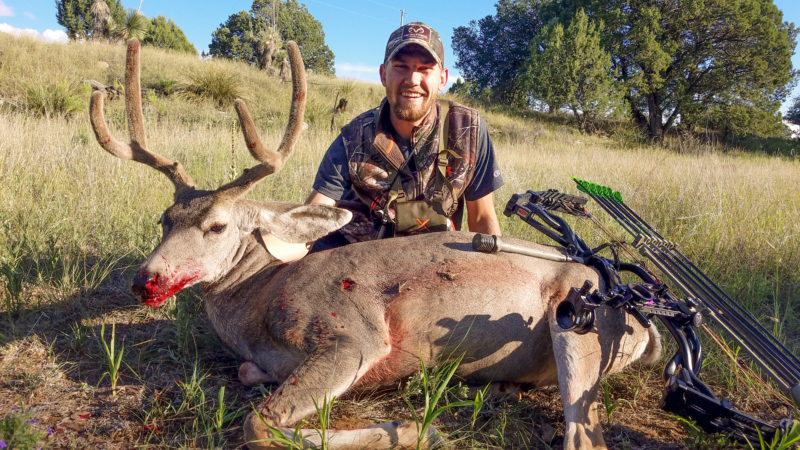
Staying Committed
During the summer, I frequently practiced shooting out to 100 yards. I knew that my setup was able to shoot at that distance accurately. However, I also knew the difference between shooting a bag target at 88 yards and shooting at a live mule deer from the same distance while having an elevated heart rate driving adrenaline through my body.
So, I consciously decided not to take that shot. I hoped to get a better shot opportunity later within my comfortable range of 60 yards or less.
Three days later, I found two of those five bucks in the same meadow. Skirting the wind, I crept in my socks along the creek bottom, rising above the grass just often enough to keep tabs on the bucks.
Taking my time, I eased into a kneeling position on a large dirt bank between the creek bottom and the meadow. If the bucks continued in the direction they were feeding, they were going to feed right in front of me. I stayed kneeling, waiting for the right moment to draw. Roughly 10 minutes passed, and I lost sight of the bucks.
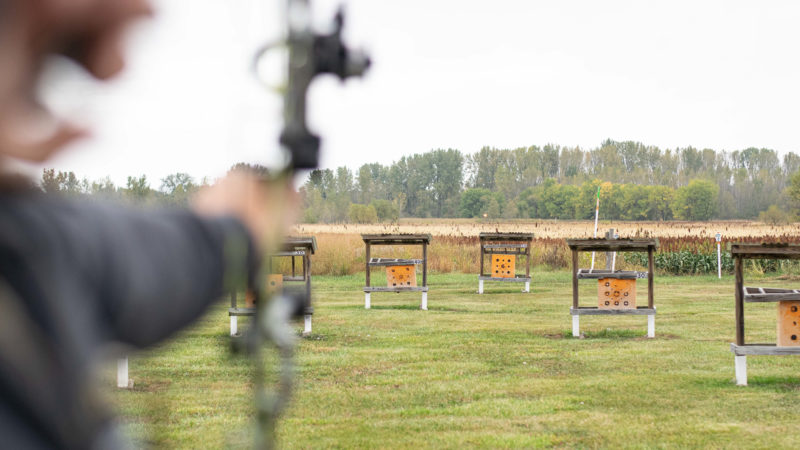
I started to think that they had seen or smelled me, when I looked to my right and saw the bucks less than 50 yards away and coming closer. As soon as they walked behind a huge cottonwood tree, I stood up. When the bucks appeared on the other side, my rangefinder immediately read 33 yards. With my heart pounding, I eased my release jaw around my D-loop. For just a moment, the buck turned the other way. My second pin settled against the crease of the buck’s shoulder, and I sent the arrow on its way. The arrow blew through the buck completely, and he piled up seconds later within sight.
The Payoff
I was filled with joy as I walked up to the buck and stroked his velvet antlers. He was the exact buck that I had passed the 88-yard shot on just a few days prior. As I worked through field dressing the buck, I fully realized the benefit of sticking to my shooting capability. By waiting off on a shot that I was merely able to take, I had been given a shot later that I was confident in making. This resulted in a perfect, clean shot and a hunt that was completed without head or heartache.
Practicing long-range shooting is both fun and a great way to gain confidence for closer shot opportunities. However, it is crucial to determine where the line is between your bow’s ability and your own shooting capability during a hunting situation. Consciously making the effort to know your maximum shot distance and utilizing self-control will help maximize your bowhunting success. This will additionally increase the overall enjoyment of your bowhunt and provide sought-after stories to be told again and again once back home.
How far is too far to shoot? Read the article HERE

 By
By 